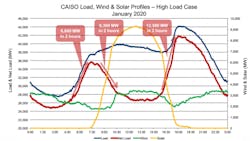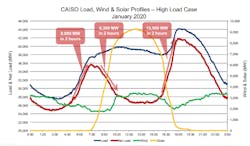Solar Will Shine Brighter With Smarter Inverters
From hula hoops and pet rocks to Silicon Valley innovations, California has historically led the way in national trends, good and maybe not so good. The Golden State has certainly carried the banner for renewable energy, certainly solar. California has encouraged residential PV solar to the degree that it could break the system. But maybe California will also lead the way to mitigating the grid operating problems caused by large amounts of solar.
This spring a number of California utilities, the system operator (CAISO), regulators and consultants met to discuss the state's looming power crisis. Seems that there is too much customer-located solar generation coming on line and the system can't adapt to handle the erratic influx of power. There's an estimate 150,000 plus systems in the state. However, no one really knows how many installations are behind the meter, not even (admittedly) the U.S. Energy Information Administration (EIA). But we know that the rate of installations is increasing rapidly. So what's wrong with that?
The problem is that the amount of generation must equal the total load (plus transfers out of the system). So, when the sun comes up and solar turns on, other sources must ramp down, and when the sun goes down other generation must ramp up. Here's a CAISO projection of what 2020 could look like:
The curve to watch is the net load (red), which is the amount of generation that must be supplied apart from wind and solar. Since the sun goes down at the same time the system load peaks, conventional generation must ramp up by 13,500 MW in 2 hours. The problem is that most large generation can't ramp that quickly. Certainly not nuclear, not coal. And to make things worse, a number of faster ramping coastal gas powered generators are being shut down due to environmental regulations, greatly reducing grid flexibility.
The California grid definitely feels the bumps when the sun comes up or goes down - so much so that utility experts are stating publicly that they see blackouts on the horizon, within the next couple of years, unless actions are taken!
But can't the utility just somehow back off or turn off solar when the grid starts getting unstable? Nope. Unlike most other regions, by law the California grid must accept qualifying renewables as they are offered, without regard to the impacts on the system. And don't expect a moratorium on new solar connections anytime soon.
There's another major issue that mostly involves smaller distributed solar. The inverter (which converts the DC solar output to AC) is designed to shut the rooftop system down when the grid voltage and/or frequency falls below specified levels. The unit remains off until turned back on by the customer.
So here's a very possible scenario: during an early summer afternoon when the solar units are running full blast and the system is near peak load, a major conventional generator goes off line. Conceivably, the system frequency sags enough to trip off a number of solar converters which leads to further frequency drop and very quickly the majority of rooftop solar shuts off. That would be such a huge hit on the system that it couldn't recover fast enough and blackouts would result.
So why are the inverters so sensitive? Primarily because the utility industry designed an interconnection standard for the inverters (IEEE 1547) to protect the utility workers from back feed from on-line solar systems during a system outage.
So why not change the standard? Maybe make the inverters smarter, or maybe even allow them to be turned on if they should trip off? Ah, that's precisely what the Western Electric Industry Leaders are pushing to do. We'll be following up with an interview with Mike Niggli, President and Chief Operating Officer of San Diego Gas and Electric. – stay tuned.
Of course, utility scale plants are a large portion of the state's solar generation and follow different interconnection rules. That's why 'smart inverters' are already in use for several large solar PV plants. And not just for controlling the systems during grid emergencies. These sophisticated devices can provide some valuable ancillary services to boot! You can learn all about them in "Grid-Friendly Utility –Scale PV Plants.
Whether for utility scale plants or roof top panels you can expect some big changes in inverter design. You can bet manufacturers are jumping on this like a dog on a bone.
About the Author
Paul Mauldin
Contributing Editor
Paul Mauldin has worked in the energy industry for more than 25 years, developing and implementing advanced energy technologies. As research director for Pacific Gas and Electric Co., he pioneered methodologies used in the design, maintenance and control of energy delivery systems. As a consultant, he has provided guidance to utilities and the vendor community, nationally and internationally. Mauldin holds BSEE and MSEE degrees from the University of California-Berkeley and is a registered professional engineer.

